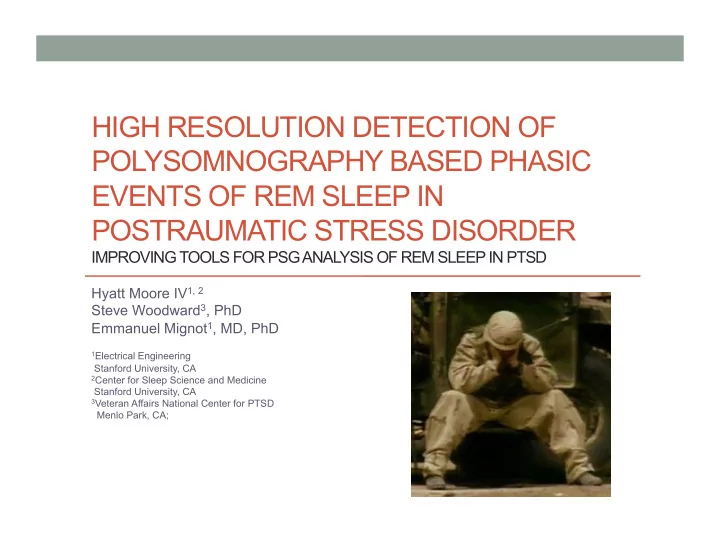

HIGH RESOLUTION DETECTION OF POLYSOMNOGRAPHY BASED PHASIC EVENTS OF REM SLEEP IN POSTRAUMATIC STRESS DISORDER IMPROVING TOOLS FOR PSG ANALYSIS OF REM SLEEP IN PTSD Hyatt Moore IV 1, 2 Steve Woodward 3 , PhD Emmanuel Mignot 1 , MD, PhD 1 Electrical Engineering Stanford University, CA 2 Center for Sleep Science and Medicine Stanford University, CA 3 Veteran Affairs National Center for PTSD Menlo Park, CA;
2.Posttraumatic Stress Disorder (PTSD) Unique anxiety disorder that develops when a person is unable or fails to recover from the stress induced by a specific traumatic event. Diagnosis under DSM-IV A. Exposure to traumatic event Actual or threatened death or serious injury, or physical threat to one’s self or others Response of intense fear, helplessness, or horror B. Intrusive recollection (re-experience) C. Avoidance/numbing D. Hyper-arousal E. Duration – more than 1 month F. Functional significance Population prevalence in U.S. 5% of men 10% of women
3. Sleep and Rapid Eye Movements Different levels of sleep analysis – and where an Electrical Engineer may be helpful Time in Bed? Time in sleep ? Cycles NREM – Non rapid eye movement Reported Differences in Sleep with PTSD Higher REM Density (REMD) in PTSD REM – Rapid Eye Movement Sleep Decreased slow wave sleep (SWS) – stage 4 Reduced time in Stage 2 Increased REM Density Tonic Decreased REM latency Phasic
4. Polysomnography Dataset 176 Vietnam era veterans 42-48 years of age (45.2, sd=3.1) Unmedicated, nonapneic 3-4 sleep studies ( 1993-1995) EEG (F3) 17 – No combat Vertical EOG 159 – Combat Horizontal EOG 143 inpatients with PTSD (DSM-IV criteria) Chin 16 participants without PTSD Polysomnography montage with REM epoch
5. Electro-oculagraphy (EOG) and its many montages Rechstschaffen and Kales (1969) Pros: Common, simple, robust Cons: One dimensional (horizontal) Assumes synchronous eye movements The human eye, modeled as a dipole, with positive polarity at the pupil, and negative polarity at the retina. Padovan and Pansini (1972) Pros: Horizontal, Vertical, and oblique eye movements Ocular Activity Cons: Less known Reference Electrode Uenoyama (1963) Salzarulo (1973) Pros: 2D tracking of each eye Pros: Horizontal, Vertical, and Insight to ocular oblique eye movements Cons: Assumes conjugative, synchrony during REM synchronous eye movements; Cons: More channels, interpretive Electrode placement complexity
6. EOG Activity Interpretations Our approach ( Uenoyama derivative ) V_EOG Pros: Horizontal, Vertical, and oblique eye movement Horizontally robust to EEG contamination H_EOG Cons: Conjugative synchrony assumed Tonic REM – no eye movements V_EOG V_EOG H_EOG H_EOG Vertical, slow eye movements (SEM) during REM Horizontal eye movement Oblique, rapid eye movement Phasic REM with possible non conjugative eye movements Reportings of disconjugate, binocularly asynchronous eye movements during REM sleep: Gabersek&Scherrer, 1970; Gabersek, 1972; Zhou&King, 1997; Ktonas et al, 2003
7. Automated 5 sec approaches to HEOG data Detectors detecting phasic 4 (Amplitude+Slope) activity in REM 3 (Amplitude+Slope) 1 (Amplitude) 2 (Slope) 5 (Spectral Analysis) Detector 1 – Liberal; groups detections; susceptible to Detectors implemented in MATLAB. slow eye movements Detector 2 – Identifies sharp/rapid changes in activity; susceptible to noisy data *Detector 3: Gopal I; Haddad G, “Automatic detection of eye movements in REM sleep Detector 3 – Conservative; short, precise detections using the electrooculagram,” 1981 Detector 4: Takahashi K, Atsumi Y, “Precise Detector 4 – Compromises between detectors 1 and 2 Measurement of Individual Rapid Eye Movements in REM Sleep of Humans,” 1997 Detector 5 – Hindered by frequency-time resolution Detector 5: Tan X,et. al, “A Simple method for computer quantification of stage REM tradeoff; rejected from further analysis. eye movement potentials,” 2001
8a. Preprocessing Techniques Filtering and De-noising Methods Unfiltered Low pass HEOG filtering (< 9Hz) High pass filtering Band pass (> 1Hz) filtering (>1Hz,<9 Hz) Wavelet de-noising Adaptive Noise Cancelling Signal with Noise = s + n d = Desired Vertical response Vertical EOG’ EOG e = error Correlated Noise = n’ Sum F3 Adaptive processor (d-y) y= output EEG K-complex K-complex diminished
8b. Preprocessing Techniques Filtering and De-noising Methods Unfiltered Low pass HEOG filtering (< 9Hz) High pass filtering Band pass (> 1Hz) filtering (>1Hz,<9 Hz) Wavelet de-noising Adaptive Noise Cancelling Signal with Noise = s + n d = Desired Horizontal response Horizontal EOG’ EOG e = error Correlated Noise = n’ Sum F3 Adaptive processor (d-y) y= output EEG K-complex K-complex diminished
Detector optimization 9. Experiment design NREM Optimization REM Dataset: Non- a. NREM combat, non PTSD, REM second night sleep studies (n=16) Apply EM detectors b. with and without Detected rapid eye movements preprocessing techniques • Horizontal EM Evaluate changes to c. EM detection in • Wavelet de-noising most impactful REM compared to NREM sleep • Vertical EM Select processing d. method based on • Adaptive noise cancelling most greatest shifts of EM detections impactful toward REM sleep
10. Detector performance after optimization (HEOG shown) EM detections in REM improve NREM EM detections reduced VEOG HEOG HEOG de-noised HEOG de-noised HEOG F3 EEG
11. Current Status Wavelet Unaltered Wavelet Adaptive with Shift* Adaptive* VEOG 36.8% 44.3% 55.7% 56.0% +19.2% in REM HEOG 48.3% 65.0% 55.3% 67.4% +19.1% in REM REM NREM REM* NREM* VEOG 716 713 285 66 Density (Count/hr) HEOG 891 740 530 158 Density (Count/hr)
12. Conclusion Phasic REM parameters detected automatically are prone to error. Horizontal EOG is robust against EEG interference Significantly benefits from wavelet de-noising Vertical EOG is susceptible to EEG interference and Significantly benefits from adaptive noise cancellation Continued work is needed to investigate phasic REM in the sleep of PTSD
Special Thanks Simon Warby Oscar Carrillo Ned Arsenault Bernard Widrow
Recommend
More recommend